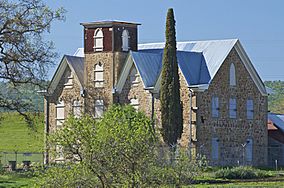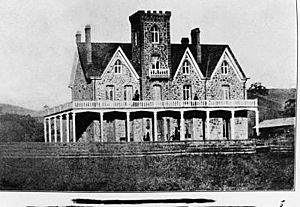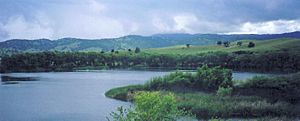Marsh Creek State Park (California) facts for kids
Quick facts for kids Marsh Creek State Park |
|
|---|---|

John Marsh House in Marsh Creek State Park, California
Photo date August 30, 2012. |
|
| Location | Contra Costa County, California |
| Nearest city | Brentwood, California |
| Area | 3,659 acres (14.81 km2) |
| Designation | State park |
| Designated | January 27, 2012 |
| Governing body | East Bay Regional Park District |
Marsh Creek State Historic Park is a special California state park located in eastern Contra Costa County. It was officially named a state park on January 27, 2012. This park covers about 3,659 acres (1,481 ha; 5.717 sq mi) of land. It is located about 3.3 miles (5.3 km) south of Brentwood. As of January 2015, the park was not yet open to the public.
The park is named after John Marsh (1799–1856). He was an important California pioneer. Marsh was a doctor, rancher, and landowner. He was the first non-Hispanic European to settle in what is now Contra Costa County. He was also the first medical doctor in California. Marsh was the first Harvard graduate in the area. He helped introduce many new crops. He was very important in helping California become a state.
Marsh was from Massachusetts. He lived in several other states before coming to Los Angeles, California. In 1838, he bought Rancho Los Meganos in northern California. This huge ranch covered over 80 square miles (21,000 ha). It stretched about 8 miles (13 km) to the San Joaquin River. Marsh reportedly paid only $300 in cowhides for this land. The park today covers part of this old ranch. The John Marsh House was added to the National Register of Historic Places on October 7, 1971.
This park is important for many reasons. It shows us about the Mexican period in California history. It was also a key place for the Miwok and other Native American people. It was home to vaqueros, who were skilled cowboys. The park was also the end point of the California Trail. The first group to cross the Sierra Nevada mountains came directly to John Marsh's ranch. The park's archaeological sites have found items from 7,000 years ago. Experts say it is the most important archaeological site in the California State Park system.
Contents
Discovering the Park's Past
Archaeologists have found that Native Americans lived in East Contra Costa County at least 7,000 years ago. Groups like the Volvone and Miwok lived in this area. Digs have uncovered human remains and other old items. Some burial sites have been found. Park planners want to protect these important cultural sites.
Ancient Cultures and Findings
Rick Fitzgerald, a State Park Senior Archaeologist, led a tour of a Marsh Creek archaeology site in 2010. The park's plan says that its archaeological sites are very special. Research shows that the first people lived here at least 7,000 years ago. Around 4,000 years ago, the Windmiller culture appeared at Marsh Creek. The Windmiller people were very advanced for their time in California. They lived throughout the Central Valley.
These findings are important because they show a rare ancient culture in California. Less than ten Windmiller sites have been found in the whole state. Even fewer have been dug up. The Windmiller culture later became what is called the Meganos people. They continued the Windmiller culture until about 1,000 years ago. Evidence of these people also exists at the park.


The Story of John Marsh's Stone House
A main attraction of the park is the home of John Marsh. Building started in 1853 and finished in 1856. The house has been worked on for many years to fix it up. Marsh was the first non-Hispanic white person to live in the county. The land that is now Marsh Creek State Park was part of Rancho Los Meganos. Los Meganos means "sand dunes" in Spanish. Marsh bought this land in 1838.
At first, Marsh lived in a four-room adobe house. Local Miwok Indians built it for him. Marsh got along well with the Miwoks. He even gave them free medical care. In return, the tribesmen built his adobe house. After he married Abby Tuck in 1851, he hired an architect named Thomas Boyd. Boyd designed a grand new mansion. Many ideas for the house came from Marsh himself. John's wife, Abby, chose the spot for the house along Marsh Creek.
The new house was built in the Gothic Revival style. It was three stories tall. It had an observation tower that rose 65 feet (20 m) high. Marsh built the tower so he could see strangers coming from far away. People often came to his ranch to steal cattle or other valuable things. However, the stone tower was not strong against earthquakes. The first tower fell during the 1868 Hayward earthquake. It was rebuilt with wood. But this new tower also fell after the 1906 earthquake. Pictures from the Library of Congress show how the two towers looked different. This house is the earliest large building in Contra Costa County not made entirely of adobe.
The Marsh mansion became known as the "Stone House." Its walls were covered with local sandstone. Abby died in 1855, before the house was finished. John moved into an upstairs bedroom in the new house around September 1856. The house was still not quite complete. John Marsh died on September 24, 1856. In 1860, the U.S. Land Commission said that over 13,000 acres (5,300 ha) belonged to the Marsh family. This land was shared by Charles and Alice Marsh. Alice was John and Abby's daughter. Charles was John's son from his first marriage.
Neither Charles nor Alice lived in the house after their parents died. The building started to fall apart. Different farmers rented the house. One renter complained in 1878 that the house was in bad shape. Later, the Balfour-Guthrie Company bought the ranch. Then the Cowell Company bought the house and land. Neither company used the house much. They spent little money on keeping it up. The south wall fell down over 20 years ago. Part of the west wall fell more recently. Cracks showed that the north wall could fall soon. Saving the house meant fixing it quickly. The roof also needed to be replaced. In 1960, Henry Cowell gave the house to Contra Costa County. In 1979, the California State Parks Department took over ownership.
Almost one million dollars has been spent since 2006 to make the house stable. This work was needed to stop the sandstone building from collapsing.
Exploring the Marsh House Design
The Marsh house is 36 by 30 feet (11.0 by 9.1 m) wide and 38 feet (12 m) tall to the roof's peak. The roof has four large dormers. This means the third story is full height. The tower is 47 feet (14 m) tall. A one-foot (0.30 m) wide portico goes around three sides of the house. Long French windows let you go from the portico into each room on the first and second floors. The house has outer walls covered with light brown sandstone. Inside the stone, there was a four-inch (100 mm) empty space. Then there was another wall made of adobe bricks.
The first floor had a stair hall that went from the front door to the back door. It also had a parlor, dining room, office, and kitchen. The parlor is 20 by 35 feet (6.1 by 10.7 m) and 12 feet (3.7 m) high. The second floor has the main bedroom right above the parlor. This bedroom can access the top level of the portico. There are two other bedrooms and a bathroom on the second floor. These rooms also access the stair hall. Another staircase leads to the third floor, which has three more rooms. A ladder goes from the third floor hall to the top of the tower.
Future Plans for the Park
There are many ideas for what the park will have in the future. These include a visitor center, walking trails, picnic areas, and parking. There will also be places for horses, campsites, and areas for special events like a farmers market. Work will soon begin to restore the Stone House. This project is mostly paid for by the California Cultural Historic Endowment. Matching donations from the John Marsh Historic Trust also help.
Building a copy of Marsh's first four-room adobe house is also being considered. The park land also has some historic Native American burial sites. Larry Myers, from the California Native American Heritage Commission, asked park officials to keep these burial sites closed to the public.
The park's main plan calls for 70 miles (110 km) of trails. It also includes an 11 acres (4.5 ha) "Primary Historic Zone." This zone will have the Stone House, the copy of Marsh's adobe house, and a copy of an Ohlone village. The original Ohlone village was near Marsh's adobe house.
Images for kids
-
John Marsh House, around 1856
-
John Marsh house, around 1870




